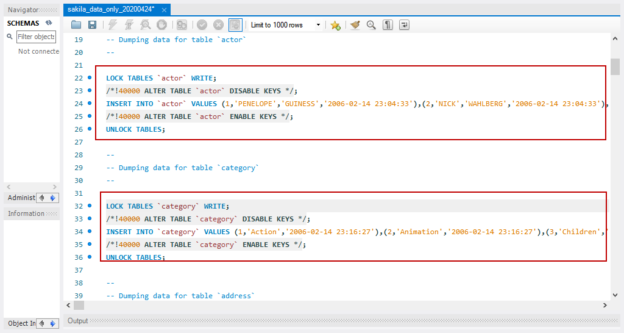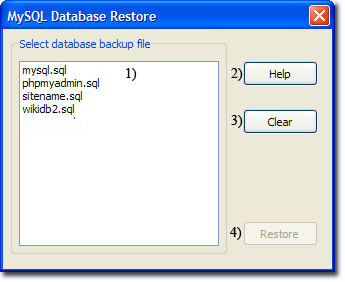

#Mysqldump restore how to#
And to learn about different ways to analyze and repair a database, make sure to read our article on how to repair MySQL database.Backing up and restoring a MySQL or MariaDB database is super easy. If you want to learn more about how to perform regular MySQL backups, check out our article about setting up master-slave replication in MySQL. But even if you’re not that lucky, it’s a fairly simple task to back up or restore. Hopefully, you only need this article to show you how to export a database in phpMyAdmin. Now you know how to back up and restore a MySQL Database using phpMyAdmin or mysqldump. (If you created your backup with different options, you can select those here.) Use the dialog box to navigate to the location where you’ve saved the export file that you want to restore. A couple of lines down, there’s a line that starts with “Browse your computer,” with a button labeled Choose File. The first section is labeled File to import. On the menu across the top, click Import.Ģ. In phpMyAdmin, the Import tool is used to restore a database.ġ. Step 3: Restore Your Backed up MySQL Database This will get rid of all the existing data, clearing the way for your restoration. The tool should prompt you to confirm that you want to go forward. Then, use the drop-down menu labeled With selected to select Drop.ģ. Open phpMyAdmin, on the navigation pane on the left, choose the database you want to restore.Ģ. This can create duplicate tables, causing errors and conflicts.ġ. If there’s any old data, it isn’t overwritten when you restore. It’s important to clear out old data before restoring a backup. Step 2: Clear the Old Database Information
#Mysqldump restore download#
If you select Quick, your web browser will download a copy of the database into your specified downloads folder. Leave the Format field set to SQL, unless you have a good reason to change it.ģ. Choose Custom to select individual tables or other special options. You’ll see a section called “Export Method.” Use Quick to save a copy of the whole database. Click Export on the menu across the top of the display. You’ll also notice that, in the directory tree on the left, all the assets under the main database are highlighted.Ģ. This should open the directory structure in the right-hand window. On the directory tree on the left, click the database you want to back up. The export function is used as a backup, and the import function is used to restore. If you’re running phpMyAdmin backing up and restoring your MySQL database is simple. Using phpMyAdmin to Back Up or Restore MySQL Make sure that you specify the exact path for the dump file you’re restoring, including server name (if needed). It’s likely that on the host machine, can be in a root directory, so you may not need to add the path. To restore a MySQL backup, enter: mysql -u -p <. Since the dump file has the commands to rebuild the database, you only need to create the empty database. This creates the foundation file that mysqldump will import the data into.

Make sure you’ve named it the same as the database you lost. On the system that hosts the database, use MySQL to create a new database. sql How to Restore MySQL with mysqldump Step 1: Create New Database To include more than one database in the backup dump file: sudo mysqldump -u -p >. To back up of an entire Database Management System: mysqldump -all-databases -single-transaction -quick -lock-tables=false > full-backup-$(date +%F).sql -u root -p
#Mysqldump restore password#
Replace with your username and password (if needed).To back up your MySQL database, the general syntax is: sudo mysqldump -u -p >. The mysqldump client utility can dump a database including the SQL statements required to rebuild the database.īy default, the dump file includes the SQL commands to restore the tables and data. Mysqldump utility (should be included with your MySQL software)īack Up from the Command-Line with mysqldump.


 0 kommentar(er)
0 kommentar(er)
